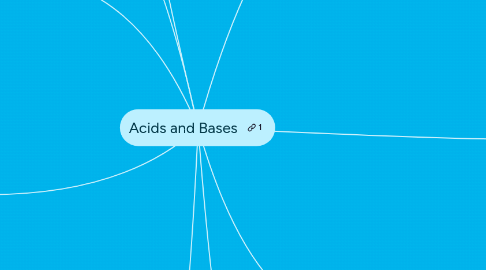
1. Strengh of alkali or acids
1.1. Strong acid or alkali
1.1.1. Examples: Hydrochloric acid(HCL) , Sulfuric acid(H2SO4) and Nitric acid(HNO3)
1.1.2. Dissociates or ionise completely in water to produce a high concentration of hydrogen or hydroxide ions
1.2. Weak acid or alkali
1.2.1. Dissociates or ionise partially in water to produce a low concentration of hydrogen or hydroxide ions
1.2.2. Example: Ethanoic acid(CHCOO3H) and Phosporic acid(H3PO4)
2. Definition
2.1. Acid : A substance which produces hydrogen ions,H+ when it is dissolved in wate
2.1.1. Note; not all substances that contains hydrogen are acids
2.2. Alkali : A substance which produces hydroxide ions,OH- when it is dissolved in water
3. Physical properties
3.1. Acids
3.1.1. sour
3.1.2. pH below 7
3.1.3. conducts electricity
3.1.3.1. strong acids conducts electricity better as the complete dissociation of acid leads to a higher concentration of hydrogen ions
3.1.4. turns moist/damp blue litmus paper red
3.2. Bases
3.2.1. bitter taste
3.2.2. pH above 7
3.2.3. soluble bases (alkali) conduct electricity
3.2.4. turns moist/damp red litmus paper blue
4. Done by: Matthias Sim, Joycelyn Lau , Ong Zi Rui and Chin Jing xian
5. importance of pH
5.1. soil
5.1.1. pH of soil:4-8
5.1.2. most plants grow well in pH around 6.5
5.1.3. causes of soil becoming more acidic
5.1.3.1. excessive fertilisers
5.1.3.2. acid rain
5.1.4. solutions to excess acidity
5.1.4.1. neutralisation
5.1.4.1.1. quicklime: calcium oxide
5.1.4.1.2. slaked lime : calcium hydroxide
5.2. environment
5.2.1. pH 4:
5.2.1.1. Acid rain (4,2-4.4),
5.2.1.2. Acidic lake 4.5
5.2.1.3. All fish die (4.2)
5.2.2. pH 5
5.2.2.1. clean rain (5.6)
5.2.2.2. frog eggs, tadpoles, crayfish, mayflies die (5.5)
5.2.3. pH 6
5.2.3.1. rainbow trout begin to die
6. Chemical reactions
6.1. Acids
6.1.1. Neutralisation: bases (products: salt and water)
6.1.2. metals (products: salt and hydrogen)
6.1.2.1. Copper, silver and gold do not react with acids as they are not reactive
6.1.2.2. test: lighted splint extinguishes with "pop" sound in presence of hydrogen gas
6.1.2.3. lead appears not to react with dilute hydrochloric acid and dilute sulfuric acid
6.1.2.3.1. layer of lead(II)chloride or lead(II)sulfate formed which is insoluble in water
6.1.3. metal carbonates (products: salt, carbon dioxide and water)
6.1.3.1. test: limewater White precipitate produced
6.1.3.1.1. Carbon dioxide+ Calcium hydroxide-> Calcium carbonate+ water
6.2. Alkalis
6.2.1. acids (products: salt and water)
6.2.2. ammonium salts (product:s salt, ammonia and water
6.2.2.1. test: moist/damp blue litmus paper
6.2.2.1.1. Ammonia turns moist/damp blue litmus paper red
6.2.3. salt (product: metal hydroxides and new salt)
6.2.3.1. For identification of cations (QA)
7. Oxides
7.1. metal oxides
7.1.1. basic oxides
7.1.1.1. oxides of all metals except for zinc, aluminium and lead(ii) (ZAP)
7.1.1.2. Same reactive properties as bases
7.1.2. amphoteric oxides
7.1.2.1. Zinc, aluminium and lead(ii) (ZAP=Zn,Al,Pb)
7.1.2.2. can behave as base or acid and they react with acids and bases
7.2. non metal oxides
7.2.1. neutral oxides
7.2.1.1. Carbon monoxide(CO), Nitric oxide( NO), Water(H2O)
7.2.1.2. do not behave as an acid or a base and it does not react with acids or bases
7.2.2. acidic oxides
7.2.2.1. oxides of all non metal except those that are neutral oxides
7.2.2.2. behave like acids. Have reactions typical of acids
8. Uses of Acids
8.1. Hydrochloric acid=remove rust from metals Sulfuric acid=make detergent,make fertilizers and used as a battery acid in cars Ethanoic acid=(in vinegar)to preserve food
9. pH scale and indicators
9.1. pH scale
9.1.1. Has a scale of 1 to 14, 1 being the most acidic, 14 being the most alkaline
9.2. Indictors
9.2.1. universal indicator; red,orange,yellow,green.blue,indigo,violet red being most acidic, violet being the most alkaline
9.2.2. Methyl orange; red=acidic, yellow=alkaline pH range for colour change:3-5
9.2.3. Litmus paper (red/blue); turns red=acidic, turns blue= alkaline pH range for colour change: 5-8
9.2.4. Bromothyl blue; yellow=acidic, blue=alkaline pH range for colour change:6-8
9.2.5. Phenolphthalein; colouress= acidic, pink=alkaline pH range for colour change:8-10
